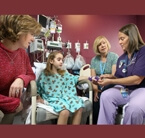
Kelly Oakey, left, says that bedside nurse reports gave her peace of mind that key information about her daughter Grace’s care wasn’t lost at shift change.
It’s long been the practice for nurses to meet outside of a patient’s room at shift change to discuss the case and transfer care. So when the medical-surgical unit of the Johns Hopkins Children’s Center decided to ask nurses to conduct shift reports at the bedside, it understandably provoked some questions about this unconventional approach.
What if I’m not that familiar with the diagnosis and parents ask questions about it? Why should I include the parents and patients at shift change if I’ve already included them all day? What if the parents seem disinterested?
Hoping that the benefits of increasing patient and family involvement would outweigh such concerns, the 16-bed unit, known as CMSC4, launched a two-month pilot of the bedside nurse report. Positive reviews from parents and nurses later convinced the unit to make it standard practice.
The bedside report touches on the same details as a standard hand-off report, such as the patient’s progress that day, unresolved issues and the goals for the next shift. But it also encourages parents to join in that discussion.
“Families get a chance to hear what has transpired during the day,” says nurse clinician Joanne Vikell. “It raises their confidence that the nurse knows what’s going on with their child, as well as what needs to be accomplished.”
Kelly Oakey, whose 9-year-old daughter Grace spent one and a half weeks on CMSC4 this fall, says the bedside report “definitely made you feel like you were part of the team.” The process gave her information that she didn’t already have, such as Grace’s most recent white blood cell counts and what they signified.
Oakey says the bedside report also gave her peace of mind, by reassuring her that vital information wasn’t falling through the cracks. The nurses, for instance, pointed out at every report that Grace was already receiving steroids for a muscle condition unrelated to her hospitalization. “It just gave me comfort knowing that I didn’t have to follow up and remind them,” says Oakey.
The new process also has altered nurse-to-nurse conversations about patients’ care. Nurse clinician Sharon Welsch, who has cared for patients on the unit for 24 years, says that in the past, nurses would rarely enter the room at shift report, doing so only when they had something specific to show the other.
The bedside report, on the other hand, gives them the chance to spot potentially deteriorating conditions. Standing at the bedside with the oncoming nurse, the outgoing nurse double-checks the patient’s emergency equipment, IVs, wound dressings and pain medication, and also ensures that the patient has the correct ID bracelet and allergy alerts.
“If another nurse is giving me her report,” Welsch says, “and I look at the patient and see an IV that looks like it might be infiltrated, she can tell me whether it looks different from when she last saw the patient.”
Some nursing staff members are still adjusting to the bedside report, and if there are sensitive issues, such as those about potential domestic violence, they still discuss them outside of the patient room. But in a survey after the pilot, 22 of 24 nurses replied that they believed that errors were being reduced due to this process, while two were unsure.
In the survey, one nurse reported finding expired tubing and missing supplies—issues that the outgoing nurse resolved before leaving. Another replied: “Several times the hand-off nurse has noticed something they forgot to do when they entered the room for report, and they followed through with it before they left.”
Bedside reporting lasts seven minutes on average—not an unreasonable burden for CMSC4 nurses who are assigned to care for three patients, Vikell says.
This story first appeared in the Winter 2011 issue of Johns Hopkins Quality Update.
